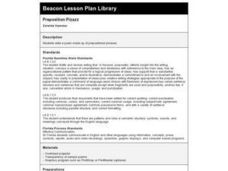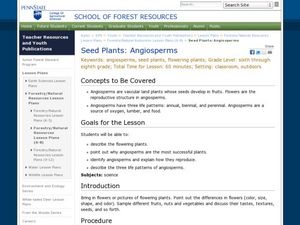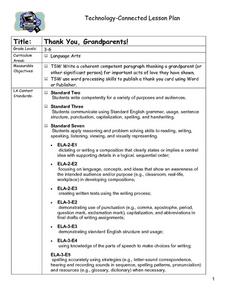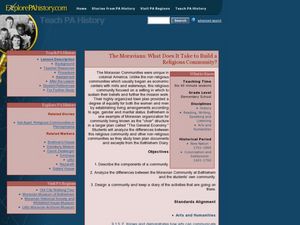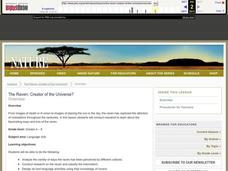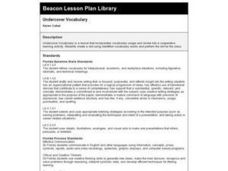Curated OER
Electron Arrangements
Pupils write electron configurations and identify groups. In this investigative instructional activity students use valence electrons to draw electron dot structures.
Curated OER
Preposition Pizazz
Students examine examples of poems and identify the prepositions in them. They write original poems using prepositional phrases and create illustrations to go with them.
Curated OER
How Many Cells Are Born in a Day?
Students predict the number of cells after a series of cell divisions. For this cells lesson students create a graph of their results and create a patterned drawing.
Curated OER
Stars and Galaxies
Eighth graders define constellations and how they are used as reference points and identify stars and constellations in the nighttime sky. They construct their own planetarium star finder and identify the location of circumpolar, zodiac,...
Curated OER
Phonics lesson for "sh"
First graders identify words with the "sh" pattern. They participate in phonemic awareness, decoding, blending, spelling patterns, and dictation exercises. As the assessment portion of the lesson, they may write a story using words...
Curated OER
Sequences and Linear Equations
Learners identify the formula to find the nth term. For this algebra lesson, students finish a pattern and identify missing parts in a sequence. They write an equation given a partial sequence.
Curated OER
The Ocean Floor
Fifth graders discuss the process of sedimentation and the continental drift theory. They locate major structures on the ocean floor and they identify life forms at each level of the ocean.
Curated OER
Grammar Lesson Plan
Students in an adult ESL class practice everyday english patterns. They identify how to use "want to", "need to" and "have to". They practice as a whole class and review concepts as necessary.
Curated OER
Mesoamerica
Students demonstrate knowledge of early Middle American civilizations. They study Mesoamerican i religions, governments, and achievements. They identify geographies of North and South America.
Curated OER
Seed Plants: Angiosperms
Middle schoolers describe flowering plants and see why angiosperms are the most successful plants. In this angiosperms instructional activity students identify angiosperms and explain how they reproduce.
Curated OER
Where No Student Has Gone Before
Students create a story about an unknown planet invaded by humans as a pre-reading activity for the novel, A Wrinkle In Time. They discuss good versus evil, and identify examples of the theme good vs. evil in books, film, and their own...
Curated OER
Unlocking New Words
Students are introduced to the various types of suffixes and prefixes. In groups, they identify the root words and determine the proper suffix or prefix to add to the root. They complete a worksheet and review their answers to end the...
Curated OER
Thank You, Grandparents!
Pupils share important moments with their grandparents. Individually, they write one paragraph thanking them for being in their lives or for a specific event they have been involved in. They also identify ways they act like their...
Curated OER
The Periodic Table
Students examine the periodic table and how it was developed. In this chemistry lesson students identify common properties and uses of elements within a family.
Curated OER
Walking on Frozen Ground
Young scholars listen to an Elder speak about permafrost structures in their area. In this permafrost lesson plan, students listen to the guest speaker, take a tour outside to view permafrost structures, and draw them.
Curated OER
Where Did My Lunch Come From? A U.S. Regional Tour
Students explore the regions from which their food comes. In this social studies lesson, students identify the different agricultural products that are found in the major regions of the United States. Students create a lunch menu.
Curated OER
Linear Sequences and Terms
Students identify the nth rule for each sequence. In this algebra lesson plan, students finish the pattern or sequence and find the missing term. They relate patterns and sequences to the real world.
Curated OER
The Moravians: What Does It Take to Build a Religious Community
Young scholars study a Moravian community, its town structure, and compare the town to other non-religious communities. In this religious community lesson, students research a Moravian community using the town plan documents and excerpts...
Curated OER
The Raven: Creator of the Universe?
Students explore biology by researching birds in class. For this raven identification lesson, students utilize the Internet to identify the anatomy, habits and habitat of ravens. Students write descriptive paragraphs about ravens and...
Curated OER
Prefixes, Un-, Re-, and, Dis-
Third graders identify prefixes and use prefixes correctly in sentences. They edit and change sentences containing prefixes.
Curated OER
Undercover Vocabulary
Fourth graders, in groups, create a skit using identified vocabulary words and perform the skit for the class. They choose a place and a person to become such as Batman, Romeo and work all the vocabulary words into their skit. They...
Curated OER
Forms of Poetry
Pupils identify distinguishing features of poetry. They identify and use literary terminology including symbol, theme, simile, and alliteration. They recognize the effects of language.
Curated OER
Science: Draining the Land - the Mississippi River
Students use topographic maps to identify parts of rivers. In addition, they discover gradient and predict changes in the channels caused by variations in water flow. Other activities include sketching a river model with a new channel...
Curated OER
Contributions of Ancient Egypt
Second graders identify the major contributions of ancient Egypt, including architectural monuments, e.g. the pyramids and Sphinx. They study the function of the pyramids as tombs for the Pharaohs.



